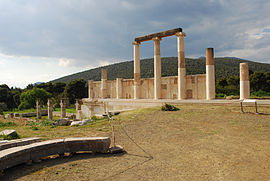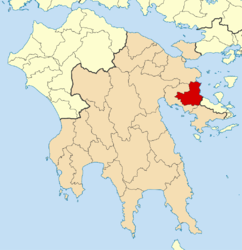Epidaurus
Epidaurus
Επίδαυρος | |
|---|---|
Settlement | |
 Abaton of Epidaurus | |
| Coordinates: 37°38′N 23°08′E / 37.633°N 23.133°E | |
| Country | Greece |
| Administrative region | Peloponnese |
| Regional unit | Argolis |
| Area | |
| • Municipal unit | 160.6 km2 (62.0 sq mi) |
| Population (2011)[1] | |
| • Municipal unit | 3,887 |
| • Municipal unit density | 24/km2 (63/sq mi) |
| • Community | 1,932 |
| Time zone | UTC+2 (EET) |
| • Summer (DST) | UTC+3 (EEST) |
| Vehicle registration | AP |
| Official name | Sanctuary of Asklepios at Epidaurus |
| Criteria | Cultural: i, ii, iii, iv, vi |
| Reference | 491 |
| Inscription | 1988 (12th Session) |
| Area | 1,393.8 ha |
| Buffer zone | 3,386.4 ha |
Epidaurus (/ˌɛpɪˈdɔːrəs/; Ancient Greek: Ἐπίδαυρος Epidauros) was a small city (polis) in ancient Greece, on the Argolid Peninsula at the Saronic Gulf. Two modern towns bear the name Epidavros (Greek: Επίδαυρος): Palaia Epidavros and Nea Epidavros. Since 2010 they belong to the new municipality of Epidaurus, part of the regional unit of Argolis. The seat of the municipality is the town Lygourio.[2]
History
Epidaurus was independent of Argos and not included in Argolis until the time of the Romans. With its supporting territory, it formed the small territory called Epidauria. Reputed to be founded by or named for the Argolid Epidaurus, and to be the birthplace of Apollo's son Asclepius the healer, Epidaurus was known for its sanctuary situated about five miles (8 km) from the town, as well as its theater, which is once again in use today. The cult of Asclepius at Epidaurus is attested in the 6th century BC, when the older hill-top sanctuary of Apollo Maleatas was no longer spacious enough.
The asclepeion at Epidaurus was the most celebrated healing center of the Classical world, the place where ill people went in the hope of being cured. To find out the right cure for their ailments, they spent a night in the enkoimeteria, a big sleeping hall. In their dreams, the god himself would advise them what they had to do to regain their health. Within the sanctuary there was a guest house with 160 guestrooms. There are also mineral springs in the vicinity, which may have been used in healing.
Asclepius, the most important healer god of antiquity, brought prosperity to the sanctuary, which in the 4th and 3rd centuries BC embarked on an ambitious building program for enlarging and reconstruction of monumental buildings. Fame and prosperity continued throughout the Hellenistic period. After the destruction of Corinth in 146 BC Lucius Mummius visited the sanctuary and left two dedications there. In 87 BC the sanctuary was looted by the Roman general Sulla. In 74 BC a Roman garrison under Marcus Antonius Creticus had been installed in the city causing a lack of grain. Still, before 67 BC the sanctuary was plundered by pirates. In the 2nd century AD the sanctuary enjoyed a new upsurge under the Romans, but in AD 395 the Goths raided the sanctuary.
Even after the introduction of Christianity and the silencing of the oracles, the sanctuary at Epidaurus was still known as late as the mid 5th century, although as a Christian healing center.
Theatre

The prosperity brought by the asclepeion enabled Epidaurus to construct civic monuments, including the huge theatre that delighted Pausanias for its symmetry and beauty, used again today for dramatic performances, the ceremonial hestiatoreion (banqueting hall), and a palaestra. The ancient theatre of Epidaurus was designed by Polykleitos the Younger in the 4th century BC. The original 34 rows were extended in Roman times by another 21 rows. As is usual for Greek theatres (and as opposed to Roman ones), the view on a lush landscape behind the skênê is an integral part of the theatre itself and is not to be obscured. It seats up to 14,000 people.
The theatre is admired for its exceptional acoustics, which permit almost perfect intelligibility of unamplified spoken words from the proscenium or skēnē to all 14,000 spectators, regardless of their seating (see Ref., in Greek). Famously, tour guides have their groups scattered in the stands and show them how they can easily hear the sound of a match struck at center-stage. A 2007 study by Nico F. Declercq and Cindy Dekeyser of the Georgia Institute of Technology indicates that the astonishing acoustic properties may be the result of the advanced design: the rows of limestone seats filter out low-frequency sounds, such as the murmur of the crowd, and also amplify the high-frequency sounds of the stage.[3]
Municipality
The municipality Epidavros was formed at the 2011 local government reform by the merger of the following 2 former municipalities, that became municipal units:[4]
- Asklipieio
- Epidavros
The municipality has an area of 340.442 km2, the municipal unit 160.604 km2.[5]
Gallery
-
Stadion
-
Gymnasion
-
Odeon
-
Terms (public baths)
References
- ^ "Απογραφή Πληθυσμού - Κατοικιών 2011. ΜΟΝΙΜΟΣ Πληθυσμός" (in Greek). Hellenic Statistical Authority.
- ^ "Λυγουριό". epidavros.gr. Retrieved 29 November 2015.
- ^ Chao, Tom (2007-04-05). "Mystery of Greek Amphitheatre's Amazing Sound Finally Solved". LiveScience. Retrieved 2007-04-05.
- ^ Kallikratis law Greece Ministry of Interior Template:El icon
- ^ "Population & housing census 2001 (incl. area and average elevation)" (PDF) (in Greek). National Statistical Service of Greece. Archived from the original (PDF) on 2015-09-21.
{{cite web}}: Unknown parameter|deadurl=ignored (|url-status=suggested) (help)
Further reading
- Arafat, K. W. (1995). "N. Yalouris: Die Skulpturen des Asklepiostempels in Epidauros. (Antike Plastik, 21.) Pp. 92; 27 figs., 69 plates. Munich: Hirmer, 1992. Cased". The Classical Review. 45 (1): 197–198. doi:10.1017/S0009840X00293244. ISSN 1464-3561. Retrieved 14 August 2018.
- Burford, Alison. 1969. The Greek Temple Builders At Epidauros: A Social and Economic Study of Building In the Asklepian Sanctuary, During the Fourth and Early Third Centuries B.C. Toronto: University of Toronto Press.
- Fossum, Andrew (1926). "Harmony in the Theatre at Epidauros". American Journal of Archaeology. 30 (1): 70–75. doi:10.2307/497923. JSTOR 497923. Retrieved 14 August 2018.
- Hartigan, Karelisa V. 2009. Performance and Cure: Drama and Healing in Ancient Greece and Contemporary America. Classical Interfaces. London: Duckworth.
- Holland, Leicester B. 1948. Thymele: Recherches sur la of Archaeology, 85, no. 3, pp. 387–400.
- Holland, Leicester B. (1948). "Review of Thymele. Recherches sur la signification et la destination des monuments circulaires dans l'architecture religieuse de la Grèce". American Journal of Archaeology. 52 (2): 307–310. doi:10.2307/500631. Retrieved 15 August 2018.
- Lembidaki, Evi. 2002. "Three Sacred Buildings in the Asklepieion at Epidauros : New Evidence from Recent Archaeological Research." In Peloponnesian Sanctuaries and Cults: Proceedings of the Ninth International Symposium at the Swedish Institute at Athens, 11-13 June 1994. Edited by Robin Hägg. Stockholm : Svenska Institutet i Athen, 123-136.
- LiDonnici, Lynn R. 1995. The Epidaurian Miracle Inscriptions: Text, Translation, and Commentary. Atlanta: Scholars.
- Melfi, Milena (2013). Galli, Marco (ed.). "Religion and Communication in the Sanctuaries of Early-Roman Greece: Epidauros and Athens". Roman Power and Greek Sanctuaries: Forms of Interaction and Communication. Tripodes. 14. Athens: Scuola Archeologica Italiana di Atene: 143–158.
- Miller, Stephen G., Robert C. Knapp, and David Chamberlain. 2001. Excavations at Nemea II: The Early Hellenistic Stadium. Berkeley: Univ. of California Press.
- Mitchell-Boyask, Robin. 2008. Plague and the Athenian Imagination: Drama, History, and the Cult of Asclepius. Cambridge/New York: Cambridge University Press.
- Peek, W. 1969. Inschriften aus dem Asklepieion von Epidauros, Berlin: Akademie-Verlag.
- Peek, W. 1972. Neue Inschriften aus Epidauros, Berlin: Akademie-Verlag.
- Tomlinson, Richard A. 1982. Epidauros. Austin: Univ. of Austin Texas.
- Vassilantonopoulos, S. L.; Zakynthinos, T.,; Hatziantoniou, P. D.; Tatlas, N.-A.; Skarlatos, D.; Mourjopoulos, J. N. (2004). Μετρήσεις και Ανάλυση της Ακουστικής του Θεάτρου της Επιδαύρου (PDF). Helina 2004 conference (in Greek). Thessaloniki: Hellenic Institute of Acoustics. trans-title=Measurement and Analysis of Acoustics of Epidaurus Theatre.
{{cite conference}}: Cite has empty unknown parameter:|1=(help); Missing pipe in:|at=(help)CS1 maint: extra punctuation (link) CS1 maint: multiple names: authors list (link) - West, M. L. (1986). "The Singing of Hexameters: Evidence from Epidaurus". Zeitschrift für Papyrologie und Epigraphik. 63: 39–46. JSTOR 20186352. Retrieved 14 August 2018.











